X-trader NEWS
Open your markets potential
10 years, 10 pictures: The history of Ethereum's crypto-ruling rule

Source: Bankless
Compiled and organized by: BitpushNews

Ethereum has now reached its 10th anniversary. After a full decade of continuous block production on its mainnet, on-chain data in 2025 shows that its activity is still growing explosively!
While alternative blockchains and Ethereum’s own Layer 2 networks have indeed diverted some user activity, Ethereum remains the beating heart of the crypto economy—it continues to lead the industry in developer momentum, censorship resistance, and numerous key on-chain metrics.
So, what does this pioneer of smart contracts look like after 10 years of development? The following 10 sets of core data illustrate Ethereum’s enduring dominance.
### 1. Stablecoin Supply
Tether, together with crypto exchange Bitfinex, pioneered USD-pegged stablecoins in 2015. Since these tokens first began on-chain migration in 2017, the supply of stablecoins on the Ethereum network has expanded at an astonishing rate.
Except for a brief decline during the worst of the last crypto bear market, the on-chain stablecoin supply on Ethereum has historically shown an almost "only rising, never falling" trend. It surpassed the $100 billion mark in late 2024 and shows no signs of slowing in recent months.
Today, there are dozens of USD-pegged token issuers, including traditional financial giants like PayPal and JPMorgan Chase. Meanwhile, the recently passed U.S. *GENIUS Act* is clearing the way for institutional adoption, and this sector—seen as an alternative medium for daily payments—is gaining attention from mainstream observers.
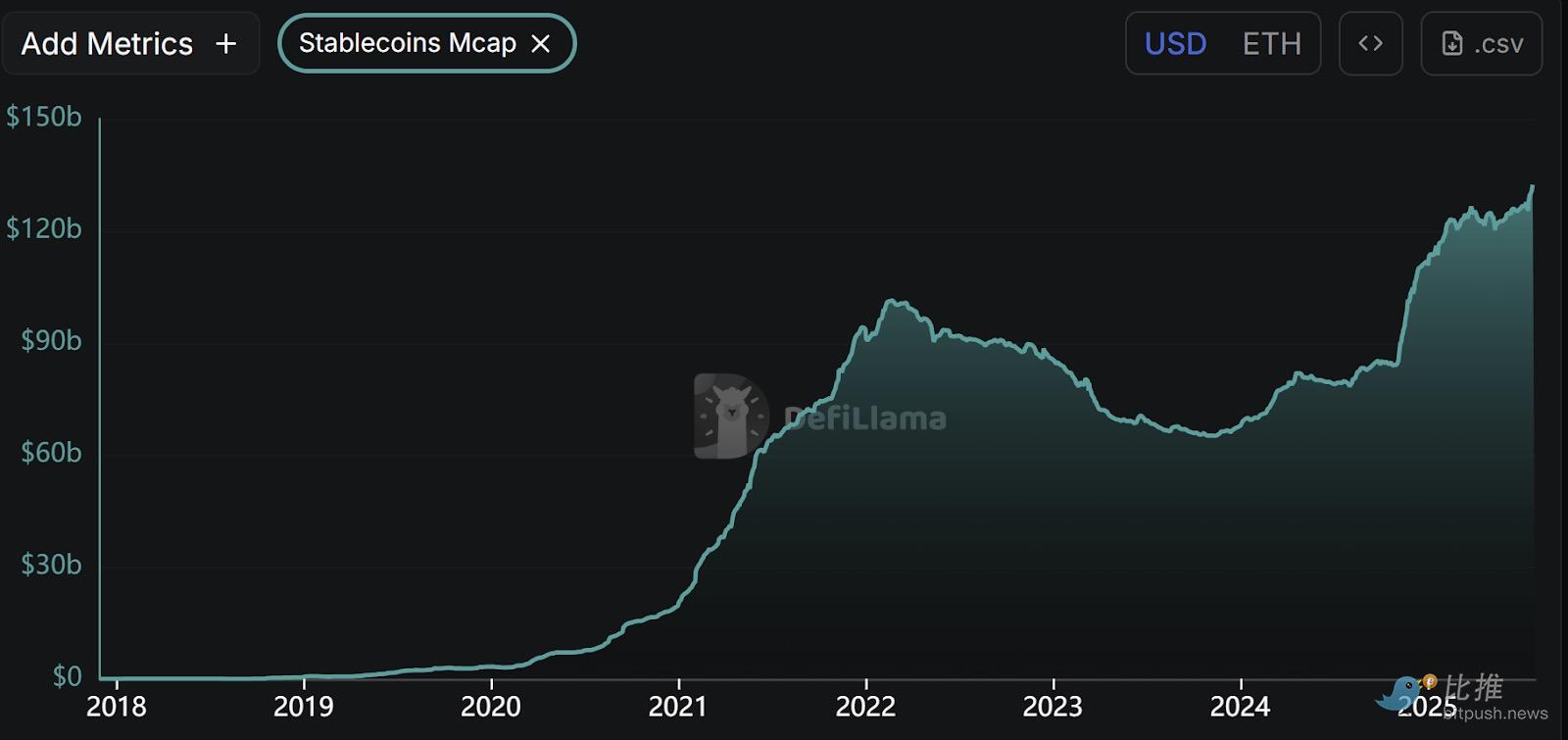
### 2. Total Value Locked (TVL)
Ethereum was the original smart contract platform. Despite multiple competing L1 blockchains and their integrated L2 networks diverting some of its locked value, Ethereum remains among the leading blockchains in terms of Total Value Locked (TVL).
TVL, the value stored in on-chain smart contracts and their associated applications, is the lifeblood of every crypto network: it represents the amount of value users trust and deposit into the on-chain financial system.
While Ethereum’s TVL was hit hard during the last bear market—when users withdrew from applications or migrated to competing chains amid plummeting cryptocurrency prices—it has grown explosively since April this year. It has reached a new cycle high of over $88 billion and is actively chasing a new all-time record.
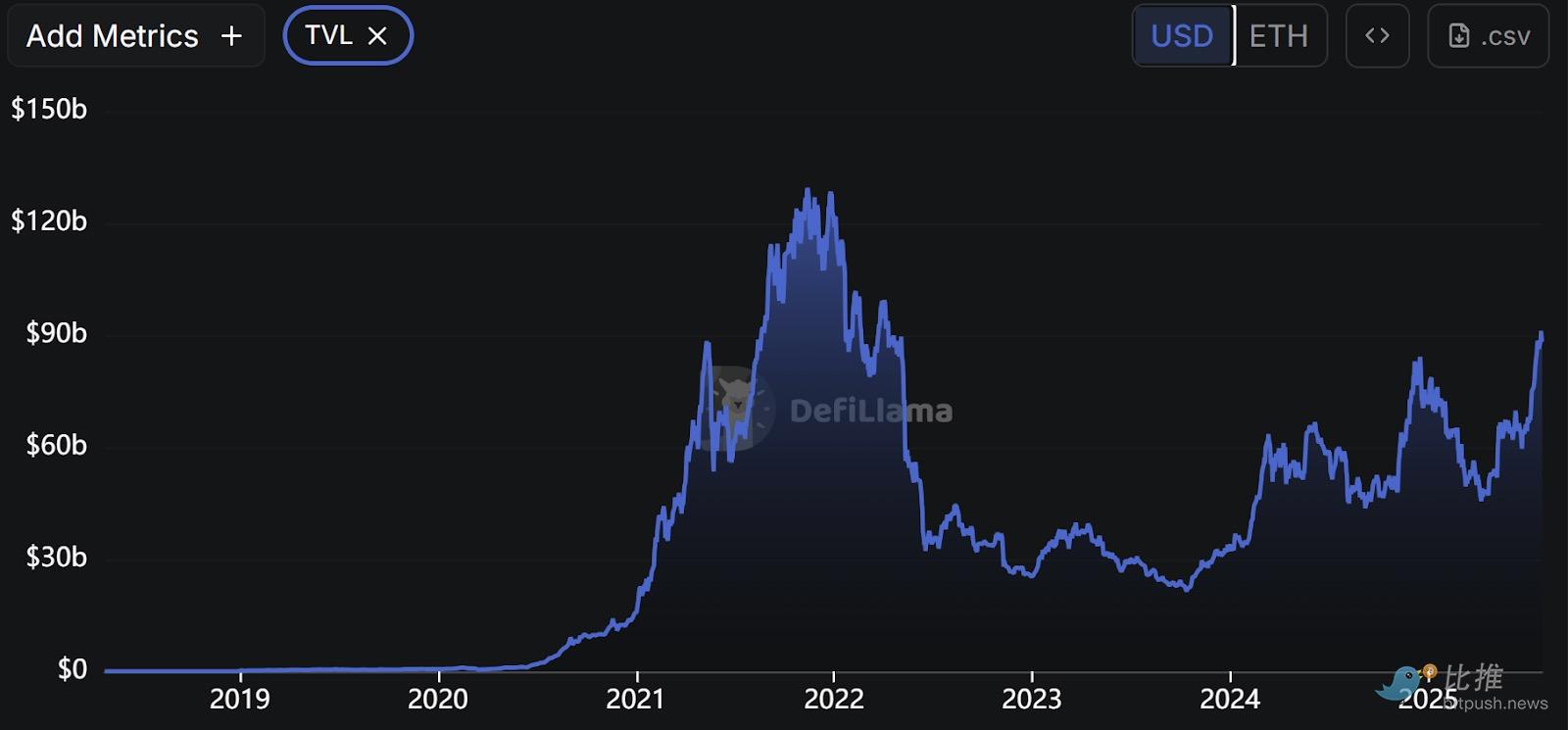
*Source: DeFi Llama*
### 3. Active Users
Even as casual user activity in the Ethereum ecosystem has migrated to L2s, it has not slowed the growth of Ethereum’s daily active users, which recently hit an all-time high of 580,000 unique addresses.
Daily active addresses remained stable during the past bear market and have continued to climb throughout 2025, with more users turning to Ethereum L1 to access the unique attributes of the world’s leading on-chain financial ecosystem.
If active addresses on Ethereum L2s are included, this growth becomes even more striking: Coinbase’s Base L2 alone sees 1.3 million daily active addresses, while leading L2s like Arbitrum, Celo, Ink, and World Chain add another 1.2 million addresses.
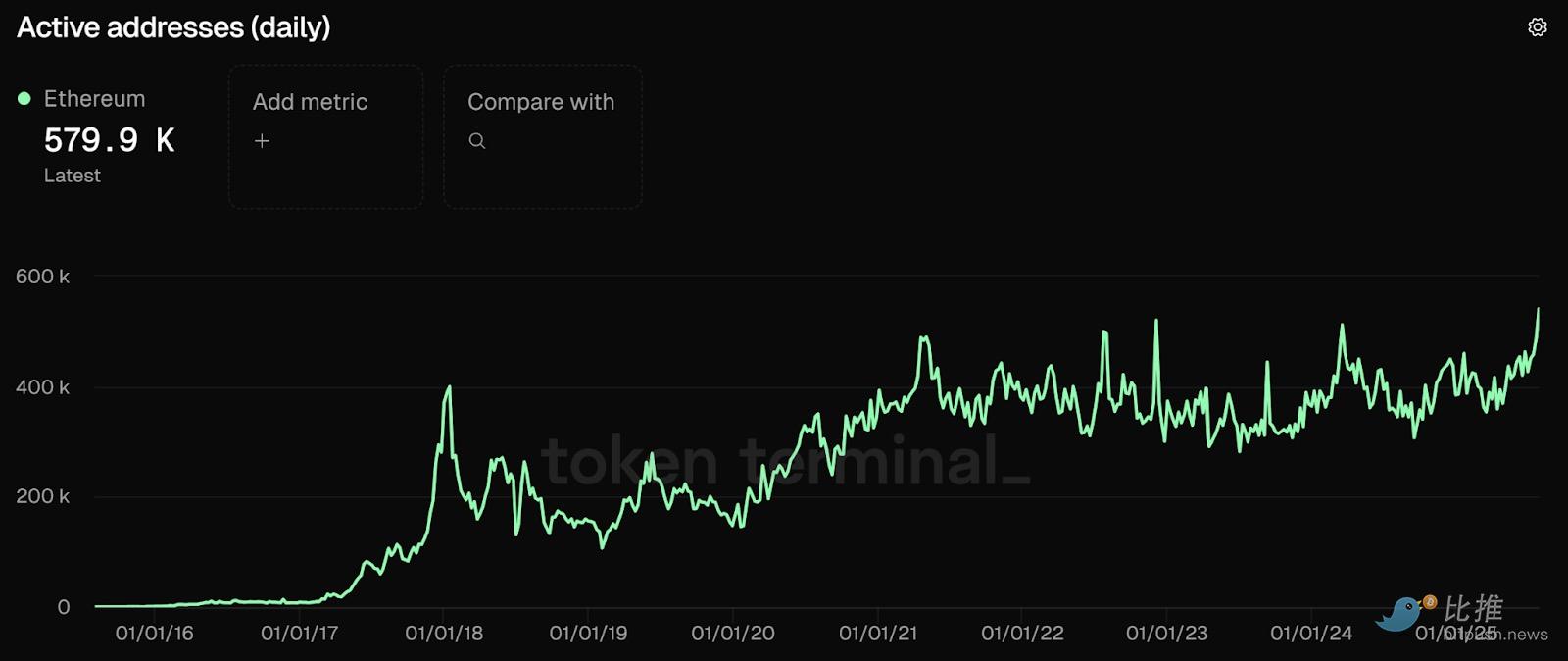
*Source: Token Terminal*
### 4. Daily Transaction Volume
As the number of active users on Ethereum L1 increases, transaction volume has followed suit. Since October 2023, daily transaction volume has risen steadily, with a floor of over 1.7 million transactions per day at the time of writing.
While this metric surges during periods of intense speculative activity, Ethereum’s daily transaction volume has historically shown a mostly "only rising, never falling" trend, with a cumulative 2.9 billion transactions completed since the network’s inception.
When accounting for Ethereum’s numerous L2s, this statistic grows even more optimistic: the Ethereum ecosystem, including leading L2s, sees well over 500 million daily transactions.
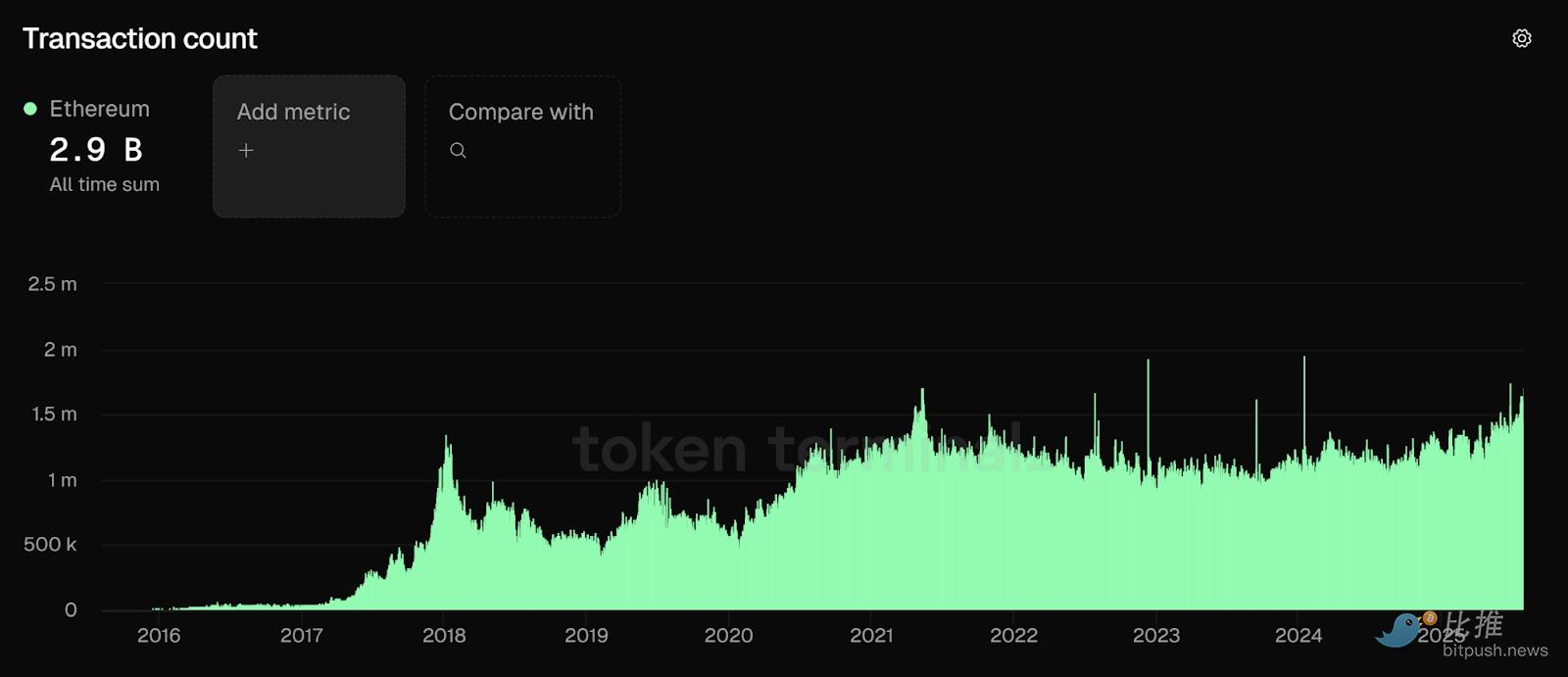
*Source: Token Terminal*
### 5. Institutional Adoption
Ethereum has long been a blockchain favored by on-chain enthusiasts, but in 2025, this crypto network broke out of its niche to become a prominent smart contract platform favored by institutional players.
President Donald Trump was an early adopter of this trend, choosing the Ethereum network in 2024 for his "World Liberty Financial Project." Banking giant JPMorgan Chase deployed deposit tokens on Base in June this year, and Ethereum L1 has established itself as the dominant platform for Real-World Assets (RWAs), controlling nearly $7 billion in value and capturing 54% of the market share in this sector.
In recent months, Ethereum treasury companies—including those led by Consensys’ Joe Lubin and Wall Street’s Tom Lee—have outshone Bitcoin competitors with massive price outperformance. Similarly, inflows into Ethereum ETFs have ballooned in recent weeks, attracting hundreds of millions of dollars daily, signaling that Ethereum mania is sweeping the retail market.
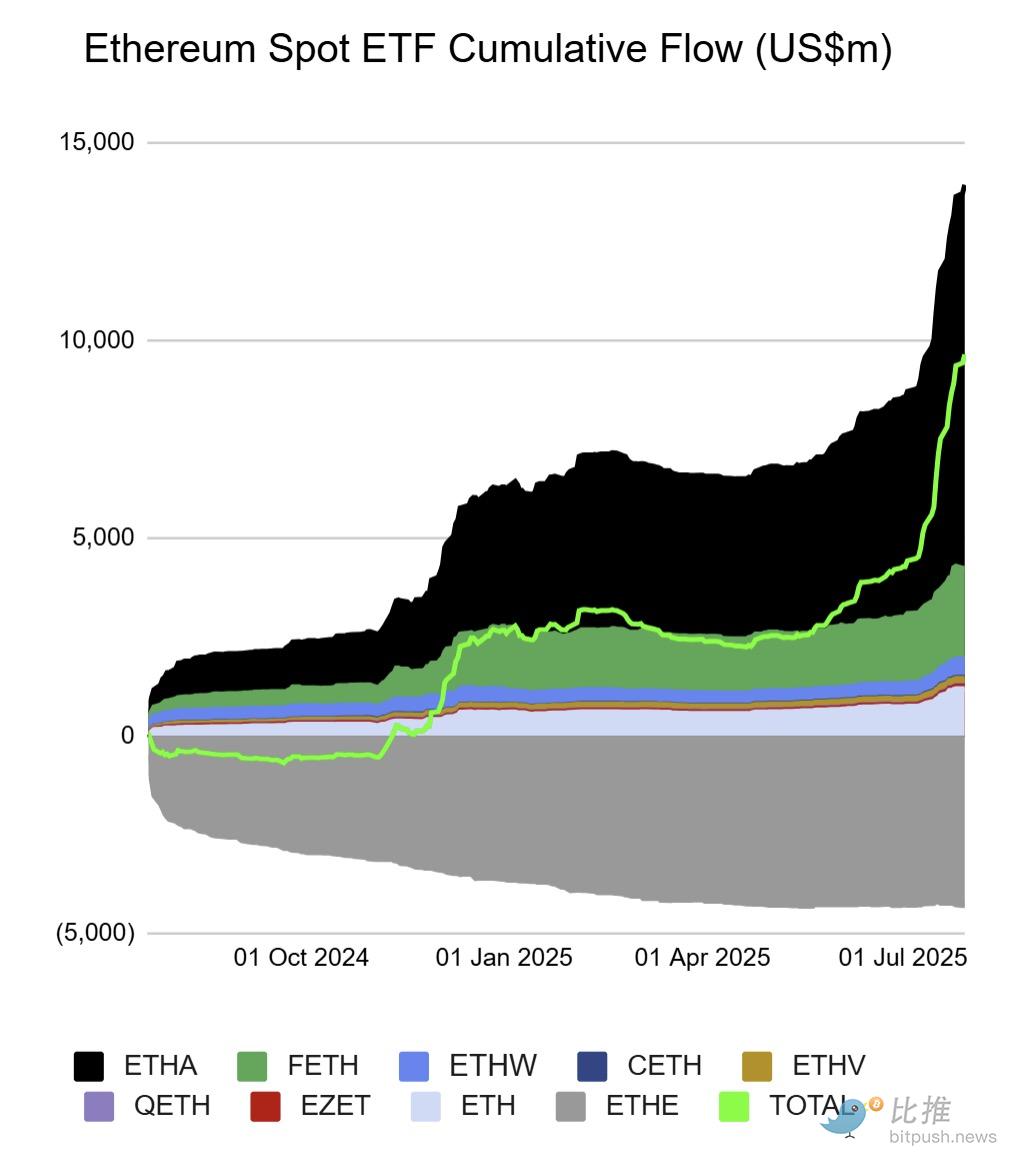
*Source: Farside*
### 6. Censorship Resistance
Ethereum L1 prides itself on censorship resistance, offering an open financial system by allowing anyone to broadcast transactions without fear that their ability to operate will be compromised by a single actor or nation-state.
Unlike other crypto networks that often roll back chains to prevent funds from reaching bad actors, Ethereum’s culture is uniquely defined by its blind trust in code, ensuring all transactions are final regardless of consequences.
These values extend to block building, where most block builders choose to process all transactions, regardless of whether the address or smart contract has been flagged as malicious by nation-state actors.
Since President Donald Trump took office, compliance with the U.S. Office of Foreign Assets Control (OFAC) sanctions list has declined significantly in 2025, and major block builders have committed to processing all transactions regardless of their origin.
Additionally, leading Ethereum developers remain committed to adopting "inclusion lists," which will force all validators and block builders to include transactions based solely on fees.
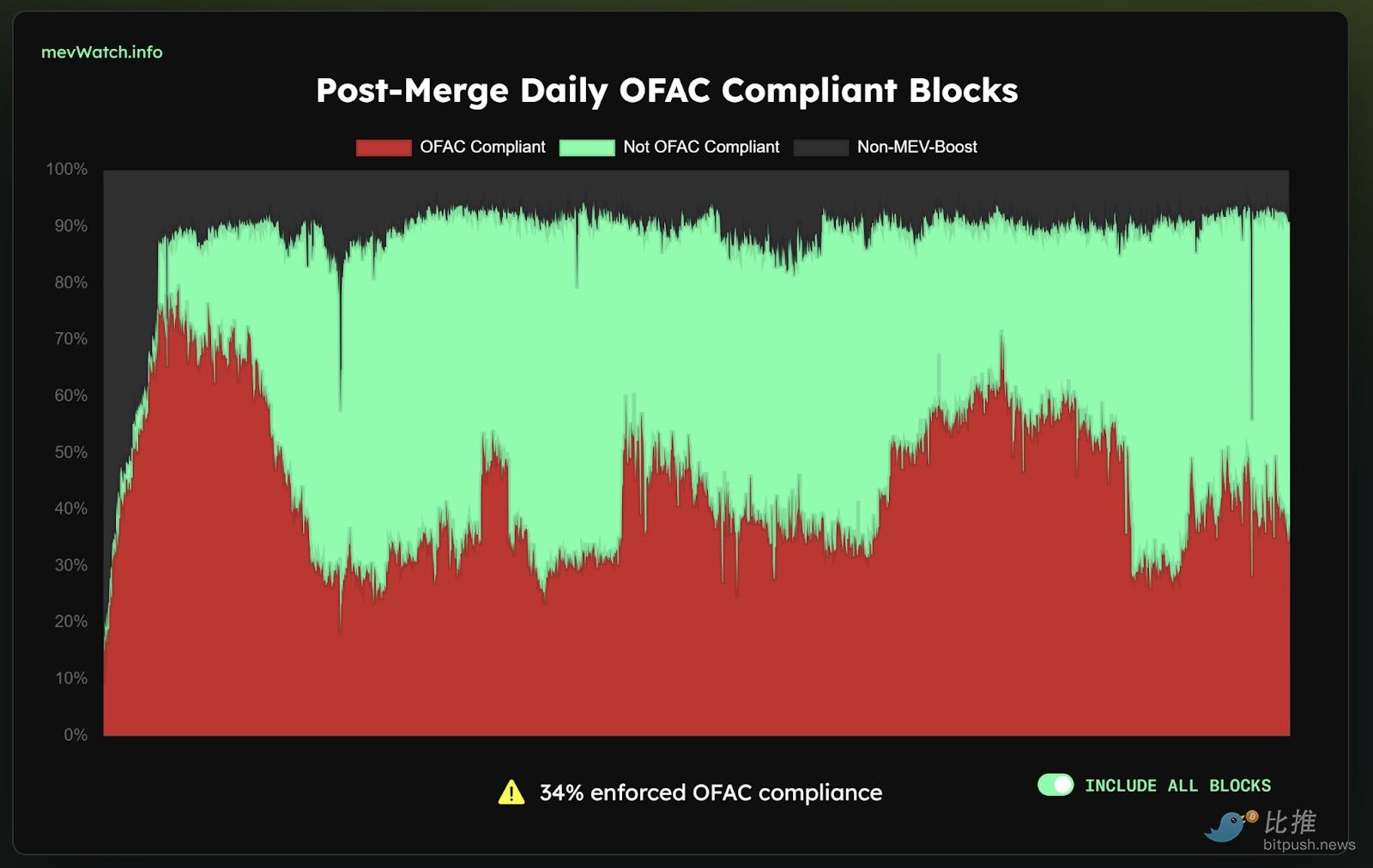
*Source: MEV Watch*
### 7. Active Developers
The state of Ethereum’s core developer community—measured by the number of unique GitHub users who have submitted code to its public repositories at least once in the past 30 days—remains strong!
While the number of active developers is below the peak of the last bull cycle, Ethereum’s core active developer count (with 186 unique contributors) still exceeds that of all other crypto projects.
Ethereum’s EVM (Ethereum Virtual Machine) has become the default standard for blockchain-based development, with its applications enjoying broad compatibility across mainstream chains.

*Source: Token Terminal*
### 8. Economic Security
Aside from a few extremely brief interruptions (the longest of which occurred between November 2024 and February 2025), the amount of staked ETH has grown steadily since staking was first enabled on the "Beacon Chain" in November 2020.
Combined with ETH’s explosive price movement, the continued upward trend in ETH staking has pushed Ethereum’s "economic security"—the value of ETH staked by validators to secure the network—to an all-time high of $140 billion.
As Ethereum’s economic security grows, users of all types can transact with greater confidence, knowing their assets are increasingly protected from malicious actors who might attempt to manipulate the blockchain ledger.
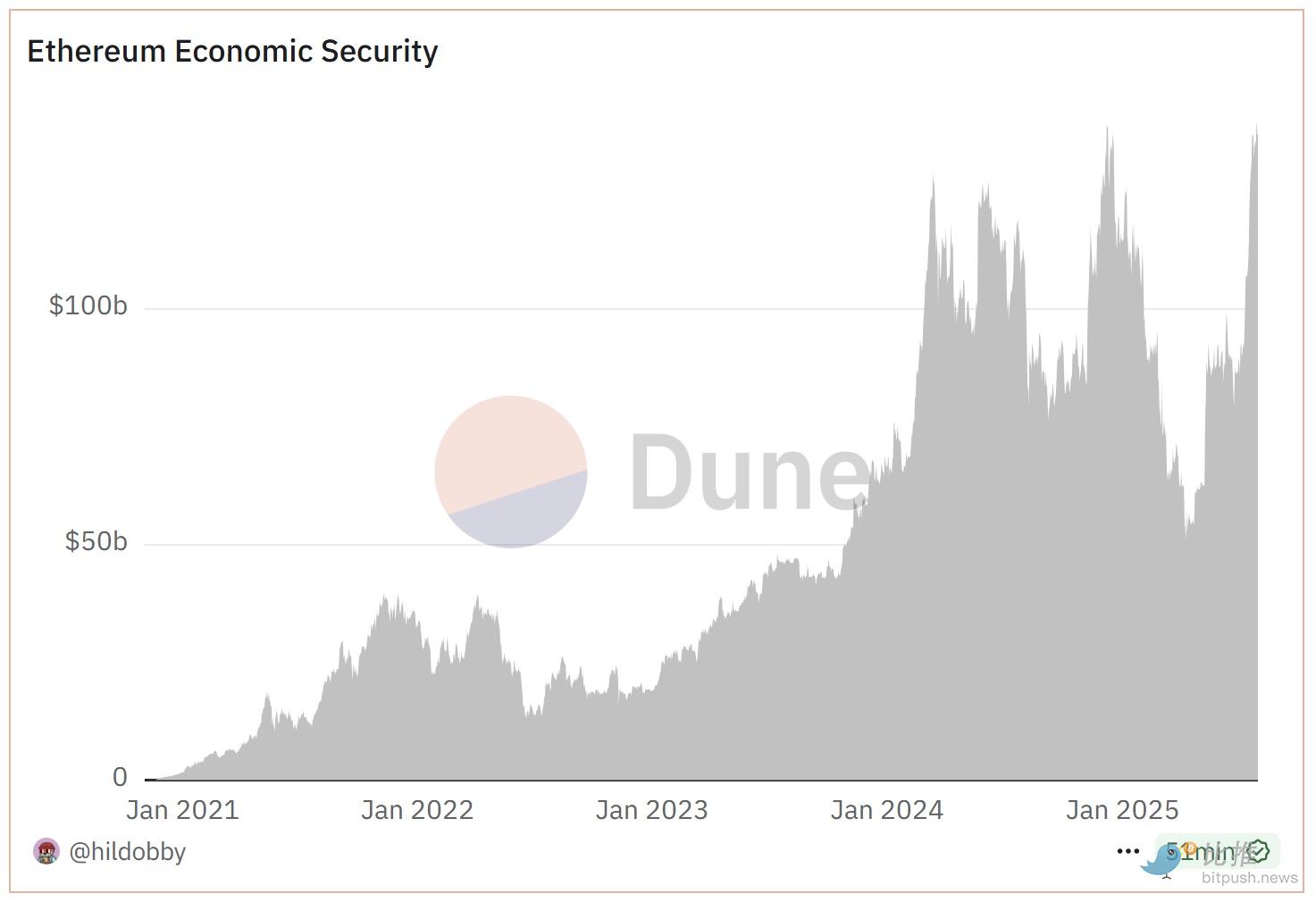
*Source: Dune Analytics*
### 9. Contract Deployments
Blockchains exist to facilitate user transactions, and contract deployments offer insight into the evolving scope of on-chain activity.
These contracts can range from simple token deployments to complex applications, but each new contract represents a potential new behavior or use case for users. In this way, contract deployments serve as a signal of on-chain innovation and growing utility.
While Ethereum contract deployments slowed in late 2024 and early 2025, they have seen a fierce resurgence in recent months, with daily new contract deployments exceeding 200,000 on multiple occasions this year. Despite developers shifting to L2s, Ethereum L1 remains a vibrant hub of activity.
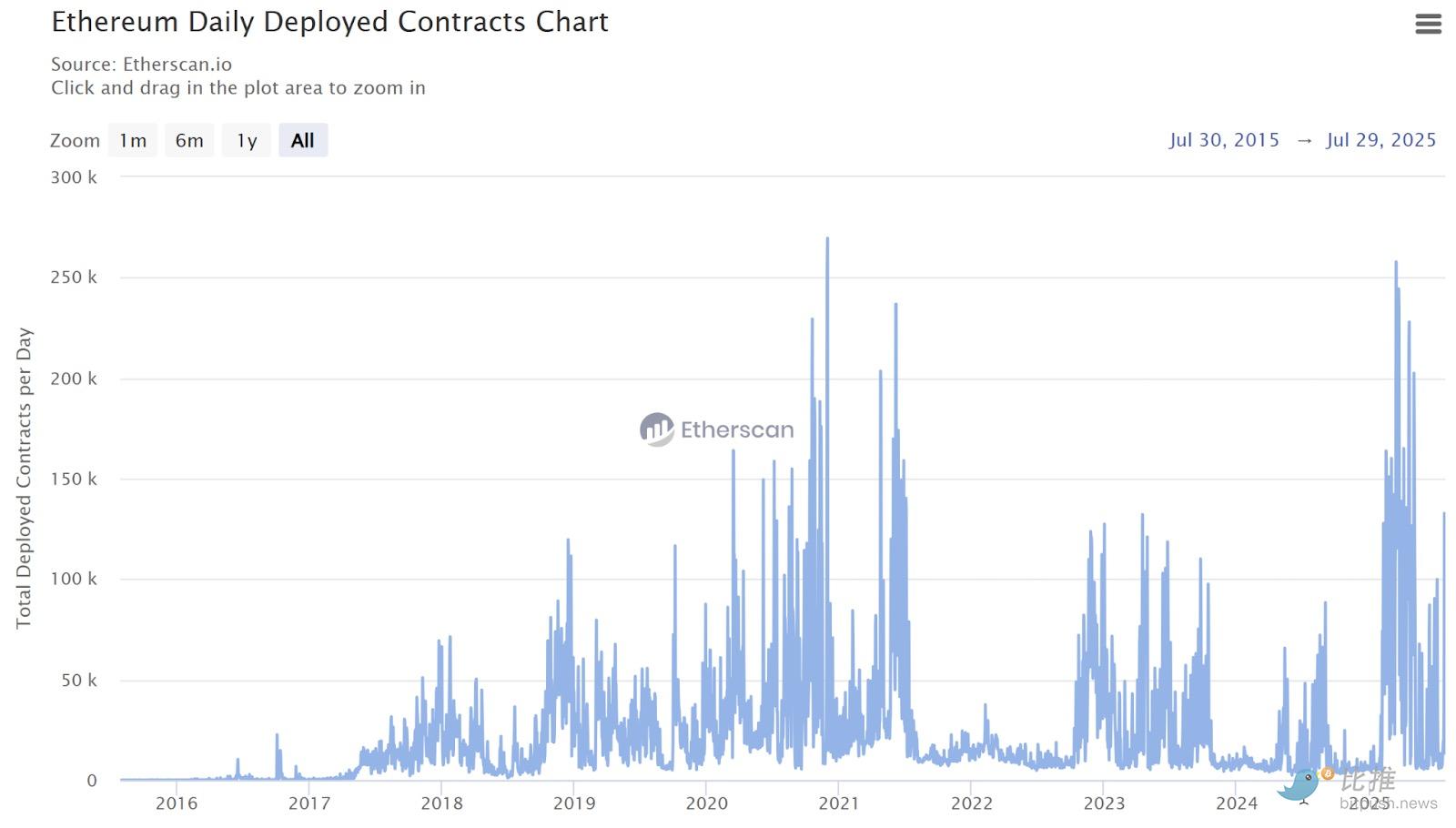
*Source: Etherscan*
### 10. ETH Price
Arguably the most closely watched success metric for any crypto project is the price of its native token. While Ethereum struggled for years against other alternative cryptocurrencies, the token has rebounded strongly since May 2025, appreciating 75% against Bitcoin.
Ethereum has emerged as one of the best-performing crypto assets in recent months, with its industry dominance nearly doubling as enthusiasm for ETH grows among crypto natives and institutional investors alike.
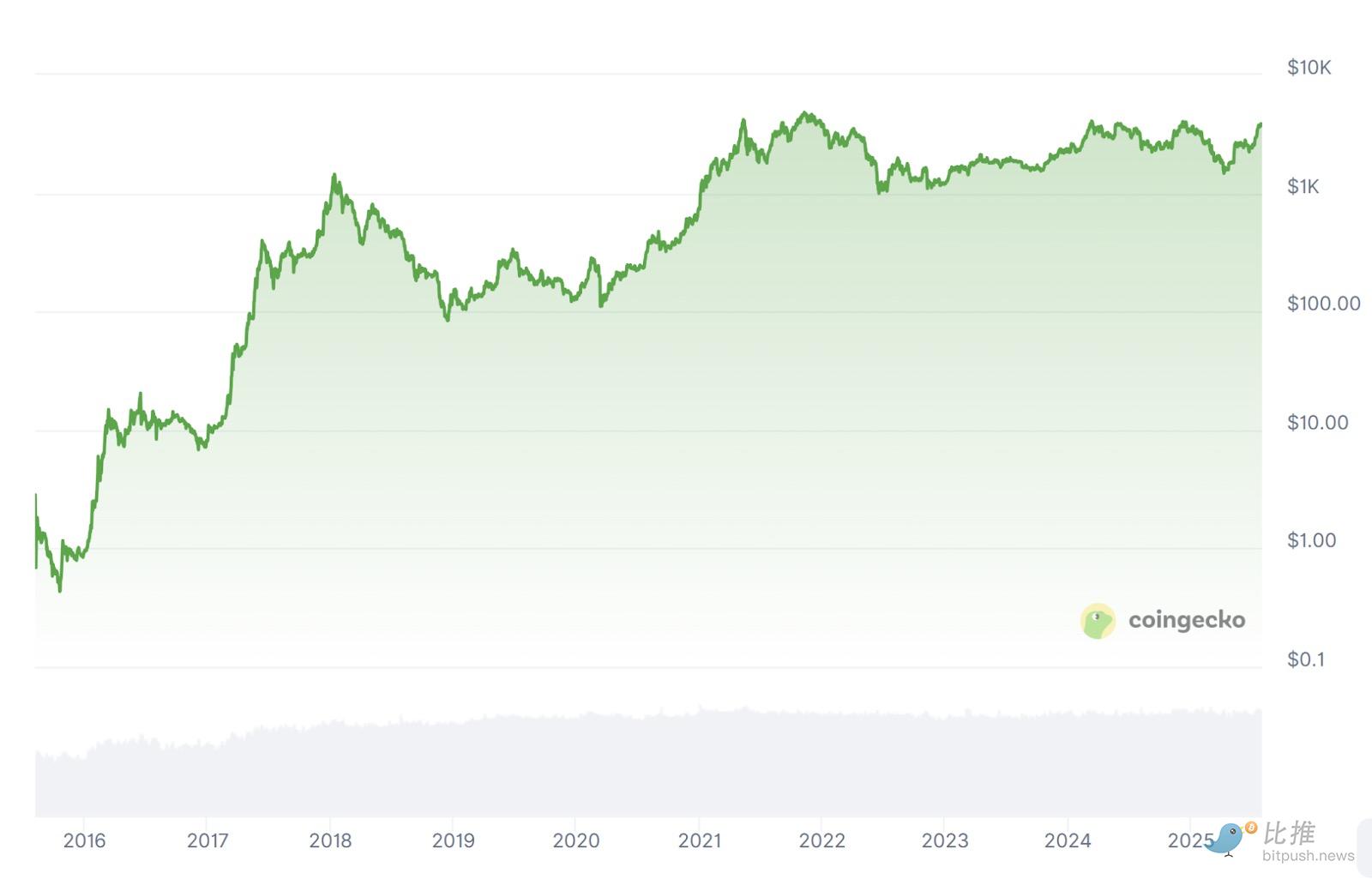
Although Ethereum is still 10% away from its all-time high, recent price performance suggests this target could be achieved within days. On a logarithmic chart, breaking this level might bring it within striking distance of $10,000...
Disclaimer: The views in this article are solely those of the author and do not constitute investment advice on this platform. This platform makes no guarantees regarding the accuracy, completeness, originality, or timeliness of the information in the article, nor does it assume any responsibility for losses arising from the use or reliance on such information.
Contact: Sarah
Phone: +1 6269975768
Tel: +1 6269975768
Email: xttrader777@gmail.com
Add: Lee Garden One, 33 Hysan Avenue, Causeway Bay, Hong Kong.